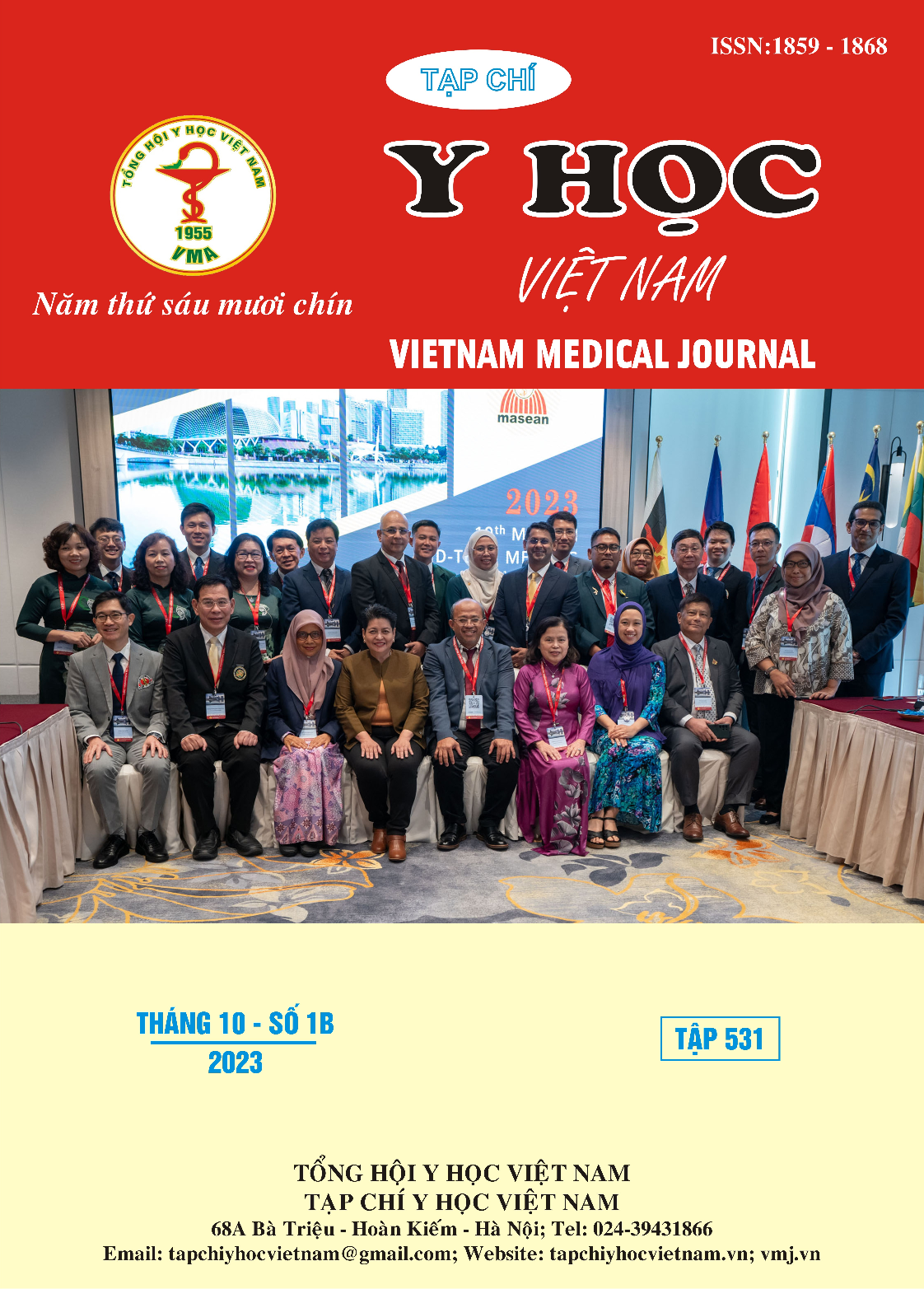KẾT QUẢ ĐIỀU TRỊ GIÃN TĨNH MẠCH THỰC QUẢN – DẠ DÀY BẰNG THẮT VÒNG CAO SU QUA NỘI SOI Ở TRẺ EM
Nội dung chính của bài viết
Tóm tắt
Tổng quan: Vỡ giãn tĩnh mạch thực quản dạ dày gây xuất huyết tiêu hóa là biến chứng hay gặp của tăng áp lực tĩnh mạch cửa với tỉ lệ tử vong cao ở trẻ em. Thắt vòng cao su qua nội soi là phương pháp chủ yếu được lựa chọn trong điều trị và dự phòng biến chứng trên. Mục tiêu: Nhận xét kết quả và tính an toàn của điều trị giãn tĩnh mạch thực quản – dạ dày do tăng áp lực tĩnh mạch cửa bằng thắt vòng cao su qua nội soi ở trẻ em. Phương pháp nghiên cứu: Mô tả loạt ca bệnh được thực hiện tại Bệnh viện Nhi trung ương từ tháng 7 năm 2022 đến tháng 6 năm 2023. Tổng số 40 bệnh nhi được điều trị giãn tĩnh mạch thực quản–dạ dày do tăng áp lực tĩnh mạch cửa bằng thắt vòng cao su và được đánh giá hiệu quả và tính an toàn sau 1 tháng. Kết quả: Tuổi trung bình của đối tượng nghiên cứu là 8,3 ± 4,9 năm và cân nặng trung bình 23,1 ± 11,9 kg (từ 8,0kg đến 54,0 kg). Phần lớn đối tượng nghiên cứu gan to (77,5%) và lách to (82,5%). Chỉ định thắt dự phòng chảy máu tiên phát được thực hiện trên 21 bệnh nhi (52,5 %) và dự phòng chảy máu thứ phát 19 bệnh nhi (47,5%). Nội soi lần 1, tỷ lệ bệnh nhân có giãn tĩnh mạch thực quản độ 4: 32,5%; độ 3: 62,5%; độ 2: 5,0%; và không có bệnh nhân gian độ 1; và giãn tĩnh mạch dạ dày 57,5%. Nội soi lần 2 sau thắt 1 tháng, tỷ lệ bệnh nhân có giãn tĩnh mạch thực quản độ 4: 8,6%; độ 3: 28,6%; độ 2: 57,1%; và độ 1: 5,7%; và giãn tĩnh mạch dạ dày 28,6%. Biểu hiện không mong muốn sau nội soi bao gồm, 2,9% bệnh nhân nuốt đau và 37,1% bệnh nhân đau sau xương ức, không có bệnh nhân nào chảy máu, thủng rách thực quản. Tỷ lệ thất bại sau soi lần 2 là 2,9% (1 trẻ 15 tháng, 8 kg, không đưa được đầu soi thắt qua cơ thắt thực quản trên). Kết luận: Điều trị giãn tĩnh mạch thực quản – dạ dày bằng thắt vòng cao su qua nội soi ở trẻ em hiệu quả và an toàn.
Chi tiết bài viết
Từ khóa
Giãn tĩnh mạch thực quản, thắt vòng cao su, xuất huyết tiêu hóa
Tài liệu tham khảo
2. Dell’Era A, Iannuzzi F, de Franchis R. Endoscopic management of variceal haemorrhage. Journal of Gastroenterology and Hepatology Research. 2015;4(3):1507-1514.
3. Cárdenas A, Fernández-Simon A, Escorcell A. Endoscopic band ligation and esophageal stents for acute variceal bleeding. Clinics in Liver Disease. 2014;18(4):793-808.
4. Lin L-L, Du S-M, Fu Y, et al. Combination therapy versus pharmacotherapy, endoscopic variceal ligation, or the transjugular intrahepatic portosystemic shunt alone in the secondary prevention of esophageal variceal bleeding: a meta-analysis of randomized controlled trials. Oncotarget. 2017;8(34):57399.
5. Cardey J, Le Gall C, Michaud L, et al. Screening of esophageal varices in children using esophageal capsule endoscopy: a multicenter prospective study. Endoscopy. 2019;51(01):10-17.
6. Lan ĐT. Nghiên cứu căn nguyên và giá trị của một số chỉ số trong chẩn đoán và tiên lượng tăng áp lực tĩnh mạch cửa ở trẻ em. Trường Đại học Y Hà Nội. 2018;
7. Laine L, Abid S, Albillos A. Portal Hypertension V: Proceedings of the Fifth Baveno International Consensus Workshop. 2011;
8. Thủy NTT. Hiệu quả của nội soi thắt vòng cao su trong dự phòng tái phát xuát huyết do vỡ giãn tĩnh mạch thực quản ở trẻ em. tạp chí khoa học tiêu hóa Việt Nam. 2016;43
9. Salahuddin M. et al, Outcome of Band Ligation in Esophageal Varices of Bangladeshi Children: A Tertiary Centre Experience, BANGLADESH J CHILD HEALTH 2017; VOL 41 (1): 28-33


